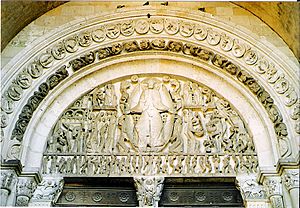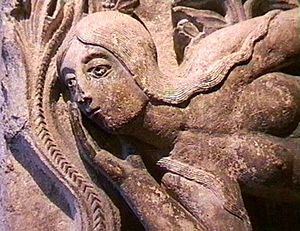Gislebertus facts for kids
Gislebertus (pronounced JIZZ-le-bert-us) was a famous French sculptor who lived in the 12th century. He is known for his amazing stone carvings at the Autun Cathedral in Autun, France. His art, made around 1120–1135, includes many doorways, large carved panels (called tympanums), and decorative tops of columns (called capitals). His work is some of the most original art from that time.
Contents
Gislebertus's Life and Work
Gislebertus began his artistic journey at the Abbey of Cluny. He likely worked as a main helper to the master sculptor there. His art often showed scenes from the Bible, capturing strong emotions. Gislebertus learned about Jesus's kindness and care, and these feelings can be seen in some of his artworks at the cathedral.
The Autun Cathedral was first built as a hospital for people with leprosy. These people were often seen as outcast. The carvings on the front of the cathedral were made to give these patients hope. Gislebertus's art was meant to be comforting and inspiring for them.
After his training at Cluny, Gislebertus moved to Vézelay. There, he created a large carved panel above the main entrance of a church. His sculptures are full of expression and imagination. One of his most famous works is the Last Judgment at Autun. This carving shows Jesus returning to Earth to judge everyone.
Gislebertus's unique style influenced many other church sculptures in France. His techniques also helped to develop the Gothic style of art that came later.
Gislebertus's Artistic Style
The name "Gislebertus" is carved on the west tympanum of Autun Cathedral. It says: Gislebertus hoc fecit, which means "Gislebertus made this." This is very special because sculptors before him usually didn't sign their work. They believed they were working for God, not for personal fame. Gislebertus was one of the first artists from the Romanesque period to put his name on his art.
Some people think the name might belong to the person who paid for the artwork, not the artist himself. However, many believe it was indeed the sculptor. Even if he had assistants, the unique designs likely came from one main artist.
Lost and Found Artworks
Over time, some of Gislebertus's amazing artworks were lost or damaged. In the mid-1700s, some church leaders thought the old Romanesque carvings looked too "barbaric." They replaced them with newer styles. For example, the head of Christ from the Last Judgment carving was removed. Other carvings of prophets were taken away completely.
The north entrance of the St. Lazare Cathedral also suffered damage. Gislebertus had carved scenes like the resurrection of Lazarus, Satan, Adam, and a beautiful Eve. This carving of Eve shows her picking the forbidden apple. It is considered one of the greatest artworks from that time.
For many years, the carving of Eve was missing. It was used as a building stone for a house built in 1769. It stayed hidden for a century until that house was torn down. Luckily, Eve was found and is now considered a masterpiece of Western art. Sadly, the carving of Adam from the same scene has not been found.
Restoring the Art
In 1837, archaeologists began to uncover the Last Judgment carving from the mortar that covered it. In 1858, an art restorer named Eugène Viollet-le-Duc repaired the tympanum. He replaced missing or broken parts with copies. However, the head of Christ was still missing.
Then, in 1948, a choir-master named Abbe Denis Grivot made an exciting discovery. He found a head of Christ in a nearby museum. He believed it was the one removed 200 years earlier. Grivot found that the sculpture fit perfectly into the tympanum! While some sculptures are still missing, many of Gislebertus's incredible works have been saved and can be seen today.
See also
 In Spanish: Gislebertus de Autun para niños
In Spanish: Gislebertus de Autun para niños



